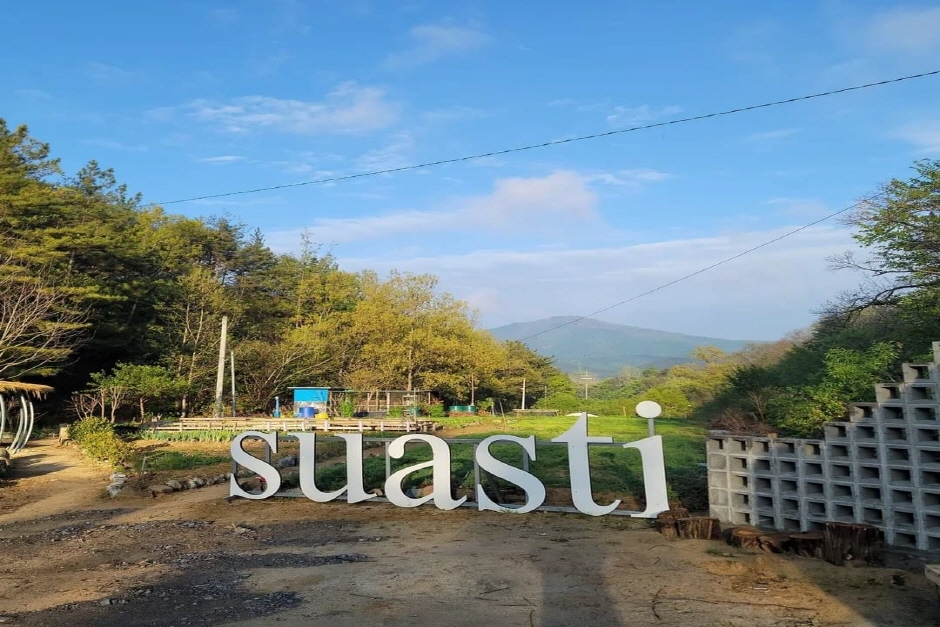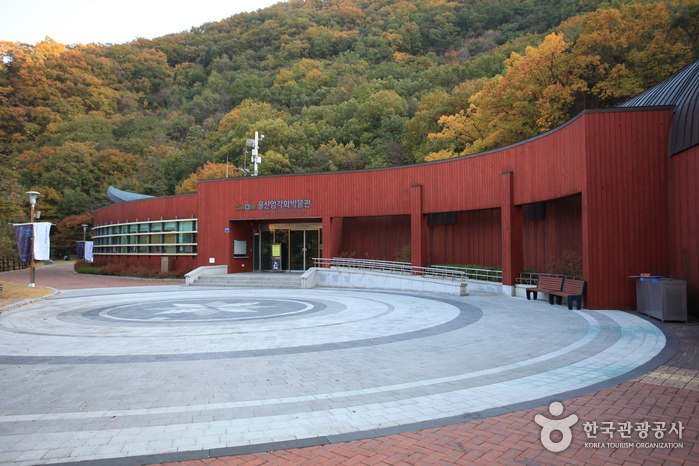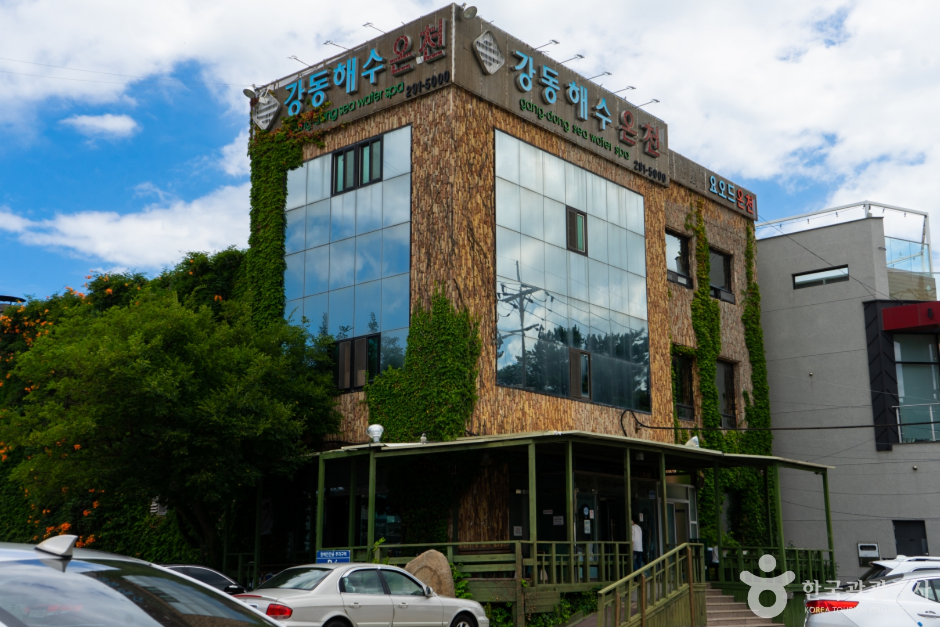Seuldo Island (슬도)
12.4Km 2023-01-03
Bangeo-dong, Dong-gu, Ulsan
+82-52-277-0101
Seuldo Island is located off the coast of Ulsan City in the southeastern part of the Korean Peninsula.
Its name, Seuldo ("seul" meaning the Korean stringed instrument geomungo), was given as the sound of wind and waves hitting the rock island is said to mimic the sound of geomungo. In fact, the sound of waves hitting the island is so good that it is called seuldomyeongpa or the resounding of waves.
The island is also known as Siruseom ("siru" meaning an earthenare steamer) for its resemblance to the upside down siru, and Gomboseom ("gombo" meaning pockmarks) for its stones with holes in them.
On the island, there is an unmanned lighthouse dating back to the late 1950s. The main economic activity on the island is fishery.
Vanastha (Healing in Ulju) (와나스타(울주에서 치유하다))
12.7Km 2025-03-28
207 Daeam 1-gil, Eonyang-eup, Ulju-gun, Ulsan
* Please be advised that this is located in one of the areas affected by the recent wildfire (as of March 27, 2025).
** For real-time wildfire information and emergency upates, visit the Korea Forestfire Information website and the National Disaster and Safety Portal.
Vanastha, located in the forest inside Daeam Dam in Ulju-gun, is a forest yoga house that means "stay in the forest." For modern people who lack time to look back on their bodies in their tired daily lives, it provides time to fully focus on themselves with proper breathing, meditation, and Hatha yoga. Here, one can hear the sounds of nature, feel nature, and experience of becoming one with nature and the universe, only in nature. It offers a one-day class and a yoga meditation program on Saturday mornings. Private session option is available for a group of four or more people with a reservation in advance.
Jujeon Mongdol Beach (주전몽돌해변)
13.4Km 2023-01-03
Jujeon-dong, Dong-gu, Ulsan
+82-52-229-6174
Jujeon Mongdol Beach is one of 12 must visit attractions of Ulsan. Jujeon meaning red ground, for the ground has a red hue. The 1.5 kilometer-long beach is filled with black pebbles and has various oddly formed rocks.
Petroglyphs of Bangudae Terrace in Daegok-ri [UNESCO World Heritage] (울주 대곡리 반구대 암각화 [유네스코 세계유산])
14.1Km 2025-07-18
Daegok-ri, Eongyang-eup, Ulju-gun, Ulsan
In Daegok-ri, Eonyang-eup sits Bangudae Terrace, a picturesque spot where a ridge of Yeongosan Mountain extends to and stands tall to form quite a spectacle featuring uniquely shaped rocks and cliffs. The name, Bangudae, comes from how it resembles a turtle lying prone on the ground. Petroglyphs are paintings drawn by people from the prehistoric times carved on rocks and depicting various scenes and events in their daily lives. Petroglyphs were often drawn on enormous rocks and other sacred locations of groups, and it is believed that people gathered around them to hold various rituals.
Petroglyphs of Bangudae Terrace in Daegok-ri, Ulju-gun are estimated to have been drawn over several periods since the New Stone Age, and visitors can observe the differences in styles among various ages. Primary objects that were popularly carved include sea animals, land animals, humans and tools and, as our prehistoric ancestors actively engaged in hunting, the hope of abundance in game is believed to be the reason why these objects were frequently carved on rocks. Vividly expressing animals and hunting scenes and colorfully depicting outstanding traits of objects, these petroglyphs are a form of both hunting art and religious art, and they are considered as the greatest masterpieces that give a peek at the life and customs of the prehistoric ages. The petroglyphs on the Bangudae Terrace and the petroglyphs in Cheonjeon-ri, spanning three kilometers altogether along the Bangucheon Stream, have been inscribed on the UNESCO World Heritage List on July 12, 2025.
Petroglyphs of Cheonjeon-ri [UNESCO World Heritage] (울주 천전리 명문과 암각화 [유네스코 세계유산])
14.8Km 2025-07-18
Cheonjeon-ri, Dudong-myeon, Ulju-gun, Ulsan
The petroglyphs (figures, pictures, and letters were made on the rocks along the mid-stream area of Naegokcheon Stream, which is a tributary of Taehwagang River. The upper and lower sides of the rocks contain petroglyphs that differ in the content and techniques used. The upper side contains petroglyphs made by means of chiseling. The inscriptions include geometric patterns, animals, and abstract human figures. There are concentric circles, with a round figure looking like the sun at the center, four running deer next to them, and several semi-human animals. The figures with simplistic expression and symbolism appear to have been made during the Bronze Age.
The lower side contains line-drawn picture mixed with Chinese characters. They include a procession of horse riders, animals including dragons, and boats. In particular, the procession of horse riders appears in three different places. The boats provide researchers with important information on the offshore activities carried out by people of the Silla dynasty. The 800-plus written characters are about the King and Queen’s visit to the place. They were presumed to have been inscribed on two occasions during the reign of King Beopheung (r. 514-540) of the Silla dynasty. The content on the official positions and the government system makes it a precious material for those studying Silla during or around the 6th Century. The petroglyphs were made by many people over an extended period of time, providing vivid information on the life and thoughts of people from prehistoric times to the Silla dynasty.
The petroglyphs in Cheonjeon-ri and petroglyphs on the Bangudae Terrace, spanning three kilometers altogether along the Bangucheon Stream, have been inscribed on the UNESCO World Heritage List on July 12, 2025.
(Source: Korea Heritage Service)
Ulsan Petroglyph Museum (울산암각화박물관)
14.9Km 2021-02-22
254, Bangudaean-gil, Ulju-gun, Ulsan
+82-52-229-4797
Ulsan Petroglyph Museum was established on May 30, 2008 at the entrance to Petroglyphs of Bangudae Terrace (National Treasure No. 285) in Ulju-gun. The museum displays 311 exhibit materials and has an exhibition hall, a storage room, a research lab, and an audiovisual room.
The exhibition hall presents models of petroglyphs of Bangudae and petroglyphs of Cheonjeon-ri (National Treasure No. 147), an educational video introducing the petroglyphs, a children’s hall, and family activity facilities. Visitors can observe reproductions of famous petroglyphs at the outdoor exhibit.
27th Ulsan Amateur Golf Tournament (제27회 울산아마골프대회)
15.2Km 2025-03-15
1 Ungchon-ro, Ungchon-myeon, Ulju-gun, Ulsan
+82-52-220-0613
The Ulsan Amateur Golf Tournament, hosted by Kyungsang Ilbo and organized by the Ulsan Golf Association, is a key event for local amateur golfers. Divided into general and senior player categories, participants compete in an 18-hole stroke game, with various awards at stake. The tournament promotes golf culture, sportsmanship, and community bonding.
Gang-dong Sea Water Spa (강동해수온천)
15.4Km 2024-02-20
1418 Donghaean-ro, Buk-gu, Ulsan
Gang-dong Sea Water Spa is a hotspring that utilizes seawater from the sea in front of Jeongja, boiling it at temperatures exceeding 100°C, resulting in high salinity and excellent sterilizing effects. The facility offers a range of baths, including Iodine Bath, Cold Seawater Bath, Hot Seawater Bath, and Trench Hot Bath. Renowned for the exceptional quality of its seawater, the hotspring attracts numerous visitors seeking its therapeutic benefits. The breathtaking view of the sea from the baths adds to the overall experience.
Ulsan Daegok Museum (울산대곡박물관)
15.7Km 2021-05-18
257, Seohacheonjeon-ro, Ulju-gun, Ulsan
+82-52-229-4787
Ulsan Daegok Museum displays artifacts that were uncovered from the area of Daegok-ri during the construction of Daegok Dam. Approximately 13,000 relics were excavated during land inspection prior to the dam construction, including Hasamjeong Ancient Tomb. These findings were collected and became available for public display when the museum opened on June 24, 2009.
Supaeseo (숲애서)
15.8Km 2025-10-23
Anti-aging and Healing Service Experience Center, 248 Tapgol-gil, Yangsan-si, Gyeongsangnam-do
Supaeseo, which opened in July 2021, is the first publicly operated healing experience center. The center helps visitors enjoy a slow and healthy life filled with love, while being surrounded by the clean forests of Daeunsan Mountain, Yangsan. Visitors can experience therapy programs, therapy meals, and recreational accommodations all in one place. The center is dedicated to improving visitors' quality of life through rest, forest therapy, and health therapy programs in the clean nature of Daeunsan Mountain.


![Petroglyphs of Bangudae Terrace in Daegok-ri [UNESCO World Heritage] (울주 대곡리 반구대 암각화 [유네스코 세계유산])](http://tong.visitkorea.or.kr/cms/resource/29/2675629_image2_1.jpg)
![Petroglyphs of Cheonjeon-ri [UNESCO World Heritage] (울주 천전리 명문과 암각화 [유네스코 세계유산])](http://tong.visitkorea.or.kr/cms/resource/14/3335114_image2_1.jpg)



 English
English
 한국어
한국어 日本語
日本語 中文(简体)
中文(简体) Deutsch
Deutsch Français
Français Español
Español Русский
Русский